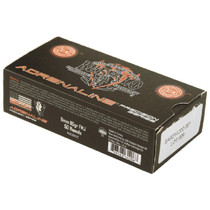Ohio's LOOMING Black Vulture Dilemma
Posted by Fin Feather Fur Outfitters on Jul 4th 2022

Ohio has two types of vultures: Turkey Vultures and Black Vultures. Both feed on dead animals and are scavengers. The black vultures are smaller and more aggressive than turkey vultures. The black vulture’s population and range have expanded since the 1980’s causing destruction within the farming community and collisions with aircraft. There are even documented cases of pet depredation.
The black vulture is considered a migratory bird, so they are protected under federal law. The only legal way of shooting them is to obtain a depredation permit from the USDA. The ODNR will pay the $100 fee for first time applicants. Shooting a black vulture without a permit issued by the USDA is punishable with fines and/or jail time. The process to obtain an application is explained at: https://ohiodnr.gov/discover-and-learn/safety-conservation/wildlife-management/nuisance-wildlife/nuisance-blackvulture
How do Black Vultures Affect The
farmers?
They have been witnessed attacking newborn calves. Black vultures will strike
shortly after birth, by attacking the eyes, nose, rectum, and other soft tissue
of newborn calves and in some cases during the actual birthing process.
Sometimes the adult cow is also injured during these assaults, sometimes even
causing death. They have been known to kill and eat lambs, goats, groundhogs
and other wild animals.
In Ohio, the most frequent request to U. S. Department of Agriculture’s
Wildlife Services is for help with black vultures. From 2012 to 2015 these
requests doubled, and black vultures continue to threaten livestock throughout
Ohio. Typically, 8 to 10 black vultures will form a semi-circle around a
newborn calf trying to back it in a corner. Once it is cornered, they will peck
out the eyes to disorientate the calf and then finish the job. They are a
vicious, mean, ugly bird. Black vultures are social so when one or two birds
find a prey animal it will attract many more making it easier to overwhelm its
prey.
If you experience losses or damages, the 2015 Farm Bill offers a Livestock
Indemnity Program administered by USDA Farm Service Agency to compensate
producers for loss due to black vultures.
How Do Black Vultures Affect
Wildlife?
Although Black Vultures are primarily scavengers and eat carrion, fish and
invertebrates they do eat wildlife. In a
scientific study in 2002 scientist collected 65 regurgitated pellets from a
roost site. The undigested pellets contained whitetail deer, raccoons, opossums,
and skunks. In addition, they identified a house cat. Although there have been
no scientific studies done in recent years it is a good bet that whitetail
fawns are most likely one of their favorite meals. A disorientated fawn with
its eyes pecked out would be easy prey.
Habits of Black Vultures
Sometimes a Black Vulture will eat so much that they must wait to digest before
they can take off. In instances where they are along a road, or a hunter walks
up on them they will upchuck their latest meal and get out of dodge. Also,
during summer months, they will defecate on their feet to cool down. On top of
all that the fact that they eat animals that have been dead and rotting for
days means they have a stomach of iron. They can thrust through even the
toughest animal hide.
Facts about Black Vultures
- Black vultures have an incredible sense of smell (although the Turkey Vulture actually has a better sense of smell) and great eyesight. They have even been called a deer dog with wings. In the unfortunate event that you wound a deer and do not find it keep an eye to the sky. It will only take a day or two for them to discover a dead deer.
- The closest relative of a buzzard is the stork.
- Their wingspan is 52”-66” and they weigh 3.5 to 6.6 lbs.
- They have no voice box but hiss or grunt when agitated.
- Black vultures’ mate for life and nest in a variety of places including trees and rocky ledges.
- Eggs are normally laid from late
April to May.
The babies will leave the nest in 10-11 weeks. - They can travel 140 miles per day and will normally nest in groups of 75-100.
Conclusion
While Black Vultures are nature’s way of cleaning up carrion, they are a huge
concern for farmers and a growing concern for wildlife managers. As their
numbers grow in Ohio prepare for more conflicts.
 | |
 |  |









